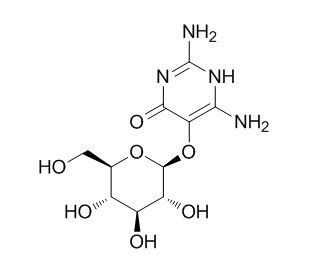Vicine
Vicine is important natural fungicide. "High levels" of vicine or convicine or both might have shortened the birds' survival time by enhancing the neurotoxicity induced by "lower levels" of beta-cyanoalanine.
Inquire / Order:
manager@chemfaces.com
Technical Inquiries:
service@chemfaces.com
Tel:
+86-27-84237783
Fax:
+86-27-84254680
Address:
1 Building, No. 83, CheCheng Rd., Wuhan Economic and Technological Development Zone, Wuhan, Hubei 430056, PRC
Providing storage is as stated on the product vial and the vial is kept tightly sealed, the product can be stored for up to
24 months(2-8C).
Wherever possible, you should prepare and use solutions on the same day. However, if you need to make up stock solutions in advance, we recommend that you store the solution as aliquots in tightly sealed vials at -20C. Generally, these will be useable for up to two weeks. Before use, and prior to opening the vial we recommend that you allow your product to equilibrate to room temperature for at least 1 hour.
Need more advice on solubility, usage and handling? Please email to: service@chemfaces.com
The packaging of the product may have turned upside down during transportation, resulting in the natural compounds adhering to the neck or cap of the vial. take the vial out of its packaging and gently shake to let the compounds fall to the bottom of the vial. for liquid products, centrifuge at 200-500 RPM to gather the liquid at the bottom of the vial. try to avoid loss or contamination during handling.
Sustainable Chemistry & Pharmacy2022, 30:100883.
Environ Toxicol.2019, 34(4):513-520.
Front Pharmacol.2021, 12:765521.
J Pharmaceutical and Biomedical Analysis2022, 114631.
Molecules.2023, 28(8):3503.
J Herbmed Pharmacol.2018, 7(4):280-286
University of East Anglia2023, 93969.
Sci Rep.2023, 13(1):21690.
New Journal of Chemistry2019, 43:12538-12547
Comparative Clinical Pathology 2021, 30:961-971.
Related and Featured Products
J Sci Food Agric. 1978 Feb;29(2):136-40.
Favism-inducing toxins in broad beans (Vicia faba). Determination of vicine content and investigation of other non-protein nitrogenous compounds in different broad bean cultivars.[Reference:
WebLink]
Vicine contents of seed coats and cotyledons of 58 cultivars of broad beans are reported.
METHODS AND RESULTS:
Seed coats contained up to 0.07% and cotyledons between 0.23 and 0.61 % a Vicine. Non-protein nitrogenous compounds in broad beans were analysed by thin-layer chromatography. Five compounds other than Vicine were isolated from broad bean extracts. These are, in order of increasing RF value, FLG, B1, D1, B2 and D2.
The possibility of existence of these compounds in different cultivars was investigated. Their ultra-violet absorption spectra in three different pH conditions are reported.
Rostlinna Vyroba, 2002, 48(12):543-547.
Fungitoxicity of natural heterocycle glucoside vicine obtained from Vicia faba L. against selected microscopic filamentous fungi[Reference:
WebLink]
Vicine and conVicine were isolated from mature seeds of Vicia faba L.
METHODS AND RESULTS:
These compounds were separated from the relevant fractions by HPLC and identified by IR, MS and NMR.
Obtained Vicine was used for all bioassays. Vicine in concentra-tion of 25 μg in 1 ml of medium had significant toxic effect. The concentration of 5 μg of Vicine in 1 ml of medium had significant fungistatic effect for fungi Fusarium culmorum and Alternaria alternata. The concentration of 500 ng of Vicine in 1 ml of medium had significant fungistatic effect for fungi Cladosporium herbarum and Botrytis cinerea. The effective concentration of Vicine in our test was significantly lower than is the concentration of Vicine in seeds and pods of V. faba. The toxicity of Vicine comparing with the toxicity of insecticide Actellic was higher by one order. Also, the fungicide Impact had a lower toxicity than Vicine. Fungitoxic and fungistatic effect of Vicine was comparable with some other test-ed fungicides and with the plant saponin digitonin.
CONCLUSIONS:
Our results confirmed that Vicine is important natural fungicide.
Int J Toxicol. 2002 May-Jun;21(3):201-9.
Vicine and convicine in common vetch (Vicia sativa) seeds enhance beta-cyanoalanine toxicity in male broiler chicks.[Pubmed:
12055021 ]
Two studies were conducted to investigate the effects of feeding raw and water-soaked vetch seeds to male broiler chicks on performance, organ weights, and blood parameters.
METHODS AND RESULTS:
Intact and ground vetch seeds were soaked in water (1:5) at room temperature for 24 hours (study 1), and (1:10) at 40 degrees C for 24, 48, and 72 hours, with water change every 12 hours (study 2). In study 1, untreated vetch contained, on dry matter basis, 0.530%, 0.731%, and 0.081% total beta-cyanoalanine (BCA), Vicine, and conVicine, respectively. Toxins were not appreciably reduced in soaked intact and ground vetch. Diets containing untreated, soaked intact, and soaked ground vetch, each at 0%, 20%, 40%, and 60%, were fed to 7-day-old male broilers until onset of neurotoxicity symptoms. Survival time was not only decreased by BCA level but also by those of Vicine and conVicine (p <.05). In study 2, 60% of untreated or treated vetch seeds were incorporated in chick diets. Although untreated vetch used in this study contained 32% less BCA but 8% and 81% more Vicine and conVicine, respectively, yet, the chicks on 60% untreated vetch showed toxicity symptoms earlier than those of study 1. Soaking ground vetch for 48 hours or more reduced BCA and totally removed Vicine and conVicine. Consequently, birds on 60% ground vetch soaked for 48 and 72 hours survived through the starter period and had mean corpuscular hemoglobin concentration and organ weights comparable to those of control at 4 days post trial.
CONCLUSIONS:
The results indicated that "high levels" of Vicine or conVicine or both might have shortened the birds' survival time by enhancing the neurotoxicity induced by "lower levels" of BCA.



